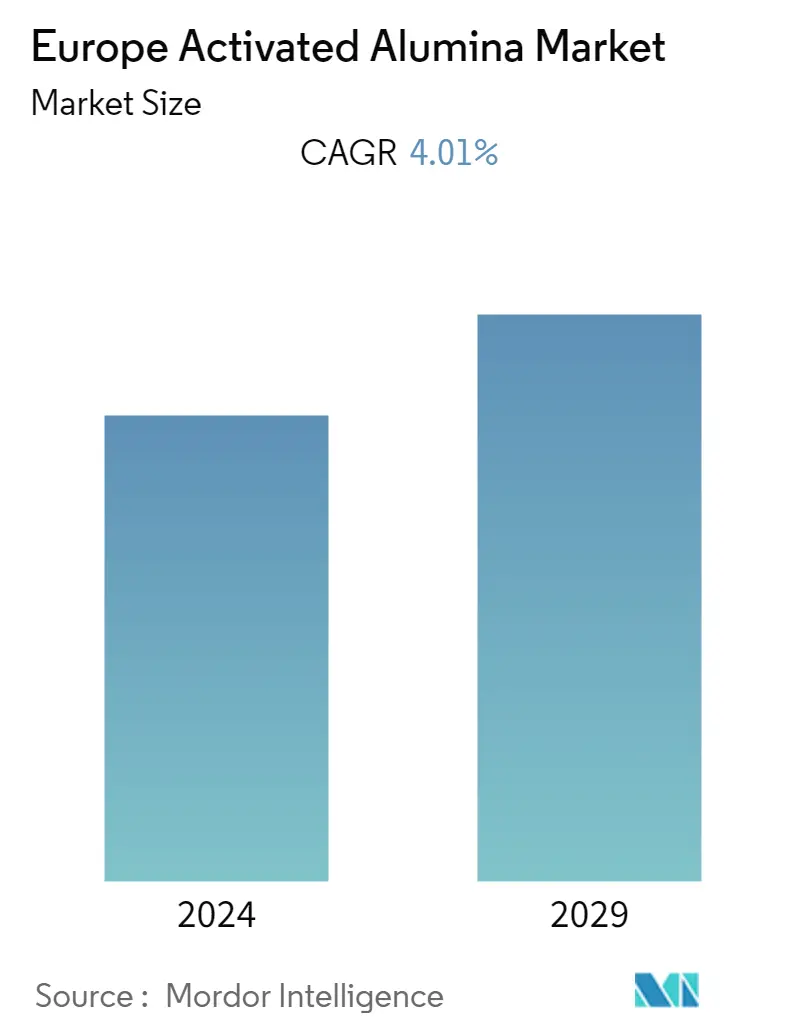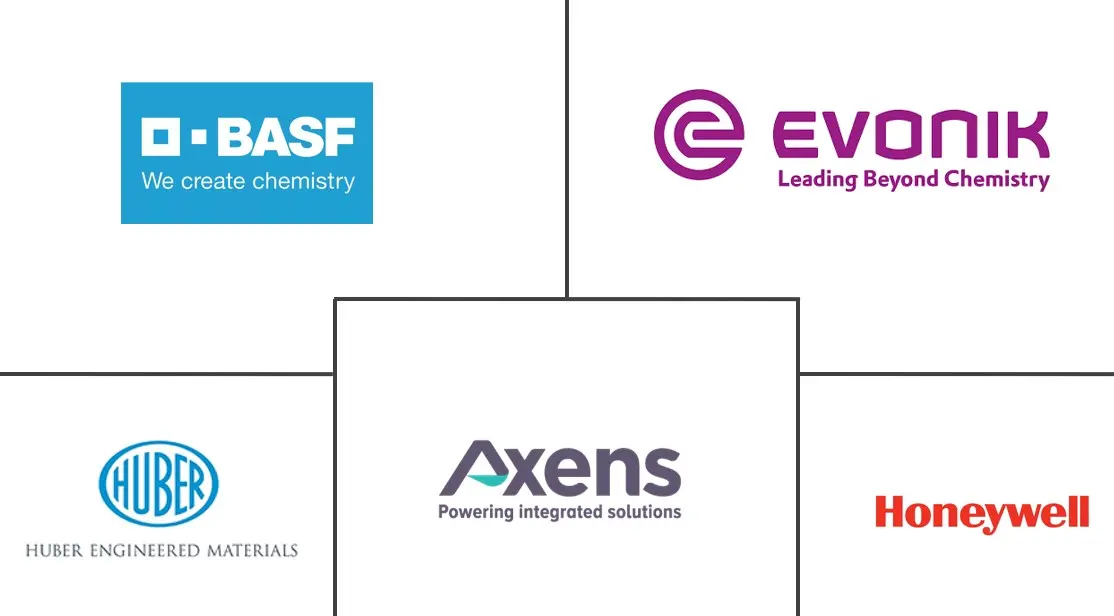Market Size of Europe Activated Alumina Industry

| Study Period | 2019 - 2029 |
| Base Year For Estimation | 2023 |
| Forecast Data Period | 2024 - 2029 |
| Historical Data Period | 2019 - 2022 |
| CAGR | 4.01 % |
| Market Concentration | High |
Major Players
*Disclaimer: Major Players sorted in no particular order |
Europe Activated Alumina Market Analysis
Europe's activated alumina market size is estimated to reach 288.15 kilotons by the end of this year and is projected to reach 350.75 kilotons in the next five years, registering a CAGR of 4.01% during the forecast period.
The COVID-19 outbreak led to nationwide lockdowns and high energy prices in Europe, impacting the market in 2020. However, the situation recovered substantially in 2021, restoring the market's growth trajectory.
- One of the major factors driving the market studied is the continuous investment in the water-treatment facilities across the region owing to increased government focus on public health and the environment.
- On the flip side, the availability of several substitutes in different end-user industries hinders the market's growth. For instance, in the water treatment industry, activated carbon and zeolite availability has been negatively impacting its market growth.
- Growing research and development on the usage of activated alumina in the textile and cosmetics industry is expected to offer various opportunities for market growth over the forecast period.
- In the European region, Germany is expected to dominate the market in terms of demand owing to the vivid presence and continuous expansion of the chemical and pharmaceutical industries.
Europe Activated Alumina Industry Segmentation
Activated alumina is a highly porous aluminum hydroxide with a large surface area. It is used in a wide range of applications, such as catalysts, fluoride adsorbents, and others. It can absorb toxic materials from wastewater and aquifers.
Europe's activated alumina market is segmented by application, end-user industry, and geography. The market is segmented by application into catalyst, desiccant, adsorbent, and other applications (biomaterial, vacuum system filter, etc.). The end-user industry segments the market into oil and gas, water treatment, chemicals, healthcare, and other industries (fertilizer, food and beverage, etc.). The report also covers the market size and forecasts in 5 countries across the European region. Market sizing and forecasts have been done for each segment based on volume (tons).
| Application | |
| Catalyst | |
| Desiccant | |
| Adsorbent | |
| Other Applications (Biomaterial, Vacuum System Filter, etc.) |
| End-User Industry | |
| Oil and Gas | |
| Water Treatment | |
| Chemical | |
| Healthcare | |
| Other End user Industries (Fertilizer, Food and Beverage, etc.) |
| Geography | |
| Germany | |
| United Kingdom | |
| Italy | |
| France | |
| Spain | |
| Rest of Europe |
Europe Activated Alumina Market Size Summary
The activated alumina market in Europe is experiencing a steady growth trajectory, driven by increased investments in water treatment facilities and the expanding chemical and pharmaceutical industries, particularly in Germany. The market's recovery post-COVID-19 disruptions has been bolstered by a heightened focus on public health and environmental sustainability. However, the presence of substitutes like activated carbon and zeolite poses challenges to market expansion. Despite these hurdles, ongoing research and development in the textile and cosmetics sectors present new opportunities for growth. Germany's dominance in the market is attributed to its robust chemical and pharmaceutical sectors, which continue to expand despite recent geopolitical challenges.
Activated alumina's role as an adsorbent and catalyst in various industrial processes underscores its significance in the European market. The German chemical industry, with its diverse specializations, has shown resilience and is expected to recover and grow, further driving demand for activated alumina. The pharmaceutical sector in Germany also presents promising prospects, with significant investments in new facilities and production capabilities. This trend, coupled with government support and strategic initiatives in water management, particularly in countries like Italy, is expected to sustain the demand for activated alumina across Europe. The market remains consolidated, with key players such as BASF SE, Huber Engineered Materials, and Evonik Industries AG playing pivotal roles in shaping its future.
Europe Activated Alumina Market Market Size - Table of Contents
-
1. MARKET DYNAMICS
-
1.1 Market Drivers
-
1.1.1 Increasing Investments in Water Treatment Facilities
-
1.1.2 Growing Demand from the Healthcare Industry
-
1.1.3 Other Drivers
-
-
1.2 Market Restraints
-
1.2.1 Presence of Substitutes
-
1.2.2 Other Restraints
-
-
1.3 Industry Value Chain Analysis
-
1.4 Porter's Five Forces Analysis
-
1.4.1 Bargaining Power of Buyers
-
1.4.2 Bargaining Power of Suppliers
-
1.4.3 Threat of New Entrants
-
1.4.4 Threat of Substitute Products
-
1.4.5 Degree of Competition
-
-
-
2. MARKET SEGMENTATION (Market Size in Volume)
-
2.1 Application
-
2.1.1 Catalyst
-
2.1.2 Desiccant
-
2.1.3 Adsorbent
-
2.1.4 Other Applications (Biomaterial, Vacuum System Filter, etc.)
-
-
2.2 End-User Industry
-
2.2.1 Oil and Gas
-
2.2.2 Water Treatment
-
2.2.3 Chemical
-
2.2.4 Healthcare
-
2.2.5 Other End user Industries (Fertilizer, Food and Beverage, etc.)
-
-
2.3 Geography
-
2.3.1 Germany
-
2.3.2 United Kingdom
-
2.3.3 Italy
-
2.3.4 France
-
2.3.5 Spain
-
2.3.6 Rest of Europe
-
-
Europe Activated Alumina Market Market Size FAQs
What is the current undefined size?
The undefined is projected to register a CAGR of 4.01% during the forecast period (2025-2030)
Who are the key players in undefined?
BASF SE, Huber Engineered Materials, Axens, Honeywell International Inc. and Evonik Industries AG are the major companies operating in the undefined.

